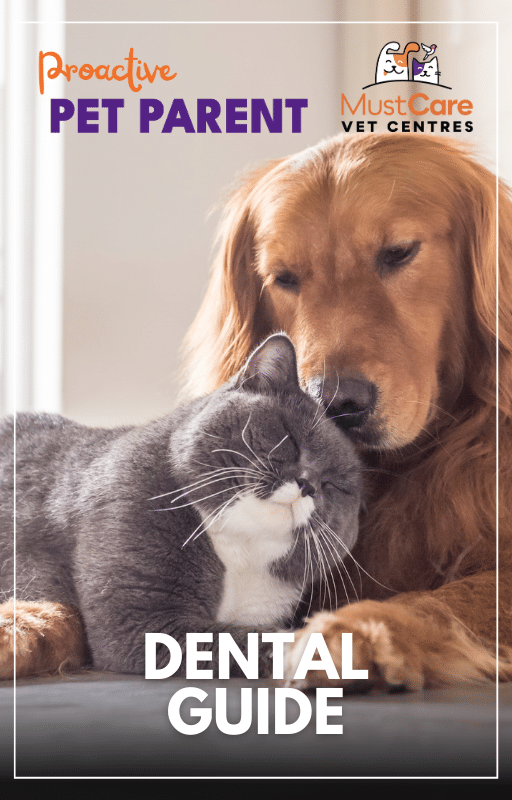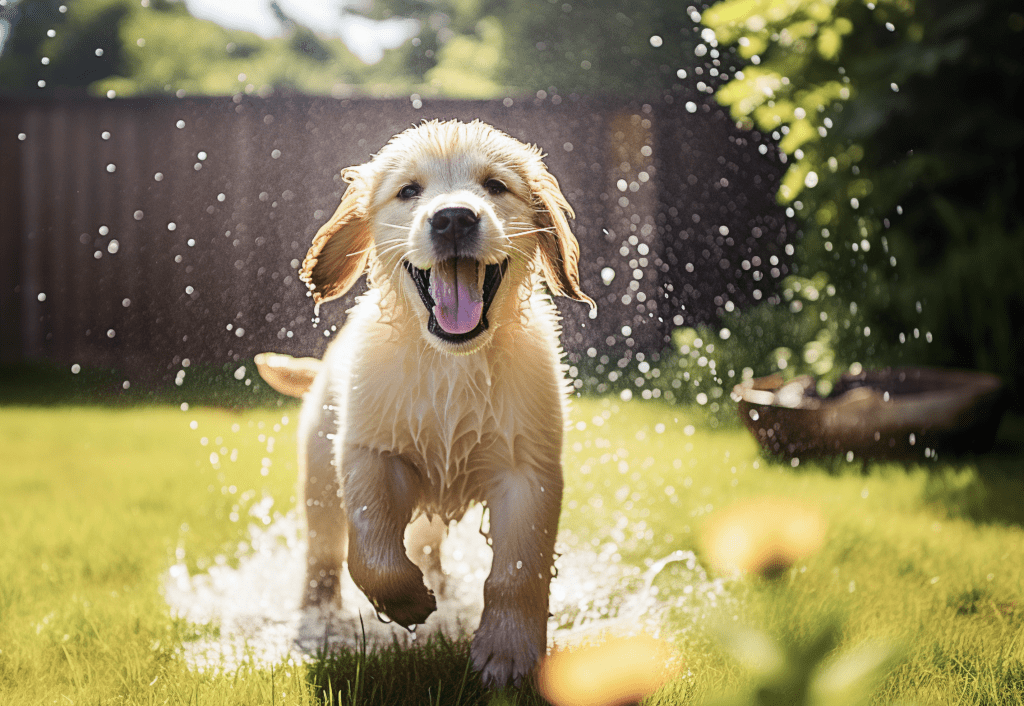Share This Blog With Other Pet Parents!
Summer Pet Care Tips: Keeping Your Pets Cool and Thriving
The scorching sun, long days by the beach, and the unmistakable hum of air conditioners mark the onset of summer. But as we swap out our woolly jumpers for sun hats and sunscreen, there’s another family member we mustn’t forget: our pets.
Just like us, our furry companions feel the brunt of the summer heat, often leading to discomfort, dehydration, or even heat-related illnesses. So, how do you ensure your beloved pets thrive during the hottest months of the year? Let’s dive in and explore summer pet care practices that every pet parent should know.
What you’ll learn from this blog:

For all you need to know, download our
FREE Dental Guide
This blog is part of our Proactive Pet Parent series! This is just the beginning… To see more blogs, click here! Better yet, sign-up to our newsletter to receive these directly to your inbox each month.
Sign-up To The Proactive Pet Parent Newsletter
The Importance of Adjusting Pet Care in Summer
Summer’s arrival often heralds images of sunlit beaches, lazy afternoon picnics, and rejuvenating vacations. But for our furry companions, the scorching temperatures and relentless sun can bring a set of unique challenges. As days get longer and temperatures soar, it becomes essential to reconsider and adapt our pet care routines.
Imagine stepping out on a sweltering day, feeling the hot sun prickling your skin. That discomfort? Our pets feel it too, but in distinct ways. For example, unlike us, dogs and cats don’t sweat through their skin. They pant to cool down, and if the ambient temperature is too high, this mechanism can be insufficient, leading to dangerous overheating. The summer season doesn’t just alter their internal thermodynamics but also affects their external environment. The pavement heats up, potentially causing harm to their paws, while the absence of cool spots can make resting an ordeal.
Factors like breed, age, coat type, and overall health can influence how they respond to summer’s challenges. While a spritely young pup might relish a splash in the pool, an older cat might prefer the quiet coolness of a shaded spot indoors.
By understanding the effects of summer on our pets and adjusting care routines accordingly, we can not only mitigate potential risks but also enhance their comfort and happiness.
Recognising Overheating and its Consequences
When the body temperature of a pet rises beyond its normal range, it can’t cool down efficiently. This situation can quickly escalate, leading to heatstroke—a condition that can be life-threatening if not addressed promptly. Common signs of heat-related stress in pets include excessive panting or drooling, increased heart rate, and lethargy. In severe cases, a pet might collapse or even lose consciousness.
Understanding the environment your pet is in becomes pivotal during summer. For instance, a car’s interior can become an oven in a matter of minutes, even with windows slightly ajar. Leaving a pet inside, even for a short duration, can have fatal consequences. Similarly, regular outdoor activities, such as walks or play sessions, should be timed during cooler parts of the day, like early morning or late evening.
Another key aspect is hydration. Just as we need to increase our water intake in the heat, pets too require ample fresh water to stay hydrated. A well-hydrated pet is better equipped to handle the heat, so ensure your pet always has access to clean drinking water.
While summer can be a fun time filled with outdoor activities and play, it’s essential to be aware of the risks the season poses. Recognising the signs of overheating and understanding how to prevent it can be the difference between a delightful summer day and a tragic one. Keeping a vigilant eye on our pets, ensuring they’re cool and comfortable, is the key to a safe summer.
Hydration – The Key to Summer Wellness
During the hot summer months, pets can become dehydrated more quickly than we might realise. Water aids in temperature regulation, and without enough of it, pets can overheat, struggling to maintain a safe internal temperature. In addition, water facilitates the removal of waste products from the body, and aids digestion, ensuring that nutrients from food are adequately absorbed.
The simplest way to gauge if your pet is getting enough water is to observe them. A pet that drinks frequently, has moist gums, and produces clear urine is likely well-hydrated. On the other hand, sunken eyes, dry gums, and reduced skin elasticity can be indicators of dehydration.
To encourage pets to drink more, pet owners can try several strategies. For those who feed their pets dry food, consider incorporating wet food into their diet. Not only is it a source of moisture, but it also offers variety, which can be appealing. Another method is to introduce water fountains specifically designed for pets. The flowing water can entice pets, leading them to drink more frequently. Consider adding ice cubes to the water bowl, or giving them as treats. The coldness can be soothing, especially after some outdoor fun.
Protecting Those Paws
During peak summer, surfaces like asphalt, concrete, and even sand can heat up significantly. When pets walk on such surfaces, the skin on their paw pads can get burnt, leading to pain, blisters, and potential infections. It’s vital to recognize the significance of this and take preventive steps.
One practical approach is to time outdoor activities either early in the morning or later in the evening when the ground is cooler. If you’re unsure about the surface temperature, place the back of your hand on the ground. If it’s too hot for you within five seconds, it’s too hot for your pet.
For those instances when avoiding hot surfaces is unavoidable, consider using protective paw wear for pets. There’s a range of pet-friendly footwear available that can shield those tender paws from the harsh ground. Not only do they provide protection, but they also offer added traction, reducing the chances of slips and falls.
Regularly checking your pet’s paws is another preventive measure. Look for signs of distress like cracks, blisters, or foreign objects. And after a long day out, a gentle wash can help remove any debris and provide a soothing relief.
In essence, while summer spells fun, it’s essential to be cognisant of the little things that can make a significant difference in our pet’s comfort. Protecting their paws ensures they can enjoy the season as much as we do, without the undue pain or discomfort.
Offering a Cool Refuge
Creating a dedicated cool space for pets is more than just a luxury; it’s a necessity. One effective method is ensuring there’s a shaded area available in your yard or garden. Natural shade from trees is ideal, but if that’s not feasible, setting up a patio umbrella or a sunshade can work wonders.
Indoors, consider placing a cooling mat or a damp towel on the floor. These surfaces absorb and dissipate heat, offering a chilled spot for pets to lie on. If you notice your pet seeking out tiles or other cold floor sections, it’s a clear sign they’re searching for relief from the heat.
Another approach is using fans or setting the air conditioning at a comfortable temperature. While pets don’t sweat like humans, circulating cool air helps in evaporating the little moisture on their skin, assisting in cooling them down.
Incorporating frozen treats into their diet can serve dual purposes: keeping them hydrated and giving them a cold snack to relish. From frozen berries to ice-cube broth popsicles, the options are endless and will undoubtedly be a hit.
Fun and Safe Summer Activities
Morning or evening walks are a smart choice. Not only are temperatures cooler during these times, but the ground is also less scorching, reducing the risk of burnt paws. Opt for grassy parks or trails, as these surfaces stay relatively cool compared to asphalt or concrete. And always carry fresh water for both yourself and your pet.
Another favourite summer pastime is water play. Whether it’s a kiddie pool in the backyard or a trip to a dog-friendly beach, many pets relish the chance to splash around. Ensure the water is clean, and keep a watchful eye on them, especially if they’re new to swimming. And for those wary of the water? A simple sprinkler can provide endless entertainment!
Interactive toys or treat-dispensing gadgets can also keep pets engaged. These tools stimulate their minds and provide physical exercise without the need for strenuous activity. It’s a win-win when the sun is at its peak.
Lastly, consider enrolling them in pet-friendly classes or workshops. From agility training to summer camps, these activities can be a fantastic way for your pet to socialize, learn new tricks, and burn off energy in a controlled environment.

Diet and Nutrition Adjustments
As summer brings about changes in our routines, our pets might benefit from some diet adjustments during these warmer months. While the basic principles of a balanced diet remain, some tweaks can ensure they stay healthy and hydrated.
Start by monitoring their water intake. In the summer heat, pets tend to drink more. Always provide a fresh bowl of water, ensuring it’s cool and easily accessible. For pets that might be more reluctant drinkers, consider adding wet food to their diet, which can offer added hydration.
Speaking of food, take note of your pet’s activity level. If you find that the warmer weather leads to more lethargy and indoor lounging, you might want to slightly reduce their calorie intake. Overfeeding, combined with less physical activity, can result in unwanted weight gain. Conversely, if you’re engaging in more outdoor activities with your pet, they may require a slight increase in their daily calorie intake.
Fresh fruits and vegetables can be a great addition to their meals. Blueberries, watermelon (seedless), and cucumbers are summer treats that many pets find palatable. However, always introduce new foods in moderation and ensure they’re safe for your specific pet.
It’s also a good time to evaluate the type of food they consume. Lighter, easily digestible meals can be more suitable for summer. If your pet has a thick coat or seems to struggle with the heat, fish-based foods, which are rich in omega fatty acids, can help improve their coat and skin, offering some relief.
In all dietary adjustments, it’s crucial to observe your pet and consult with a veterinarian if uncertain. Every pet is unique, and their needs can vary. By being proactive and making informed choices, you can ensure your pet’s diet complements their well-being during the warm summer months.
Regular Check-ups and Being Vigilant
One of the most proactive measures you can take to ensure your pet’s well-being is scheduling regular veterinary check-ups. These routine visits aren’t just about vaccinations; they offer an opportunity for a comprehensive health assessment.
Increased outdoor activities expose pets to potential threats like parasites, including ticks and fleas. Your vet can recommend preventive treatments and inspect your pet for any signs of these unwanted guests. Likewise, they can assess any skin conditions that may arise from the heat, like rashes or sunburns.
Being vigilant is crucial. Watch out for signs of heatstroke, which can be life-threatening for pets. Symptoms include excessive panting, drooling, lethargy, or uncoordinated movement. If you suspect your pet is overheated, move them to a cooler area immediately and consult your vet.
Furthermore, pets might be more prone to ingest harmful substances during summer. Barbecue scraps, certain plants, or even some summer fruits can be toxic to them. It’s important to be aware of what’s within their reach and understand what’s harmful.
Regular grooming can also play a preventive role. By maintaining a well-groomed coat, you not only help your pet stay cool but also provide an opportunity to inspect their skin closely for any abnormalities or early signs of issues.

